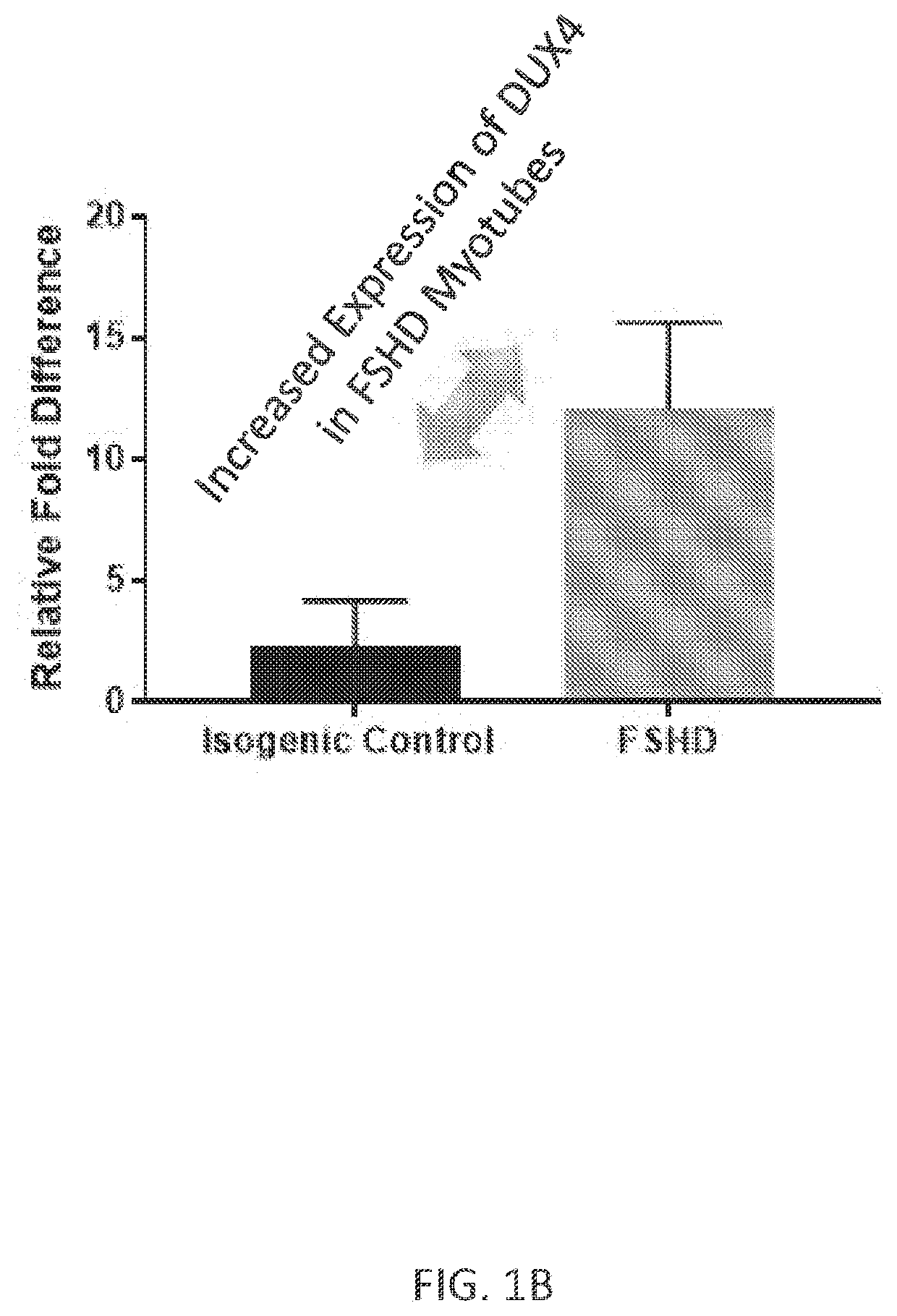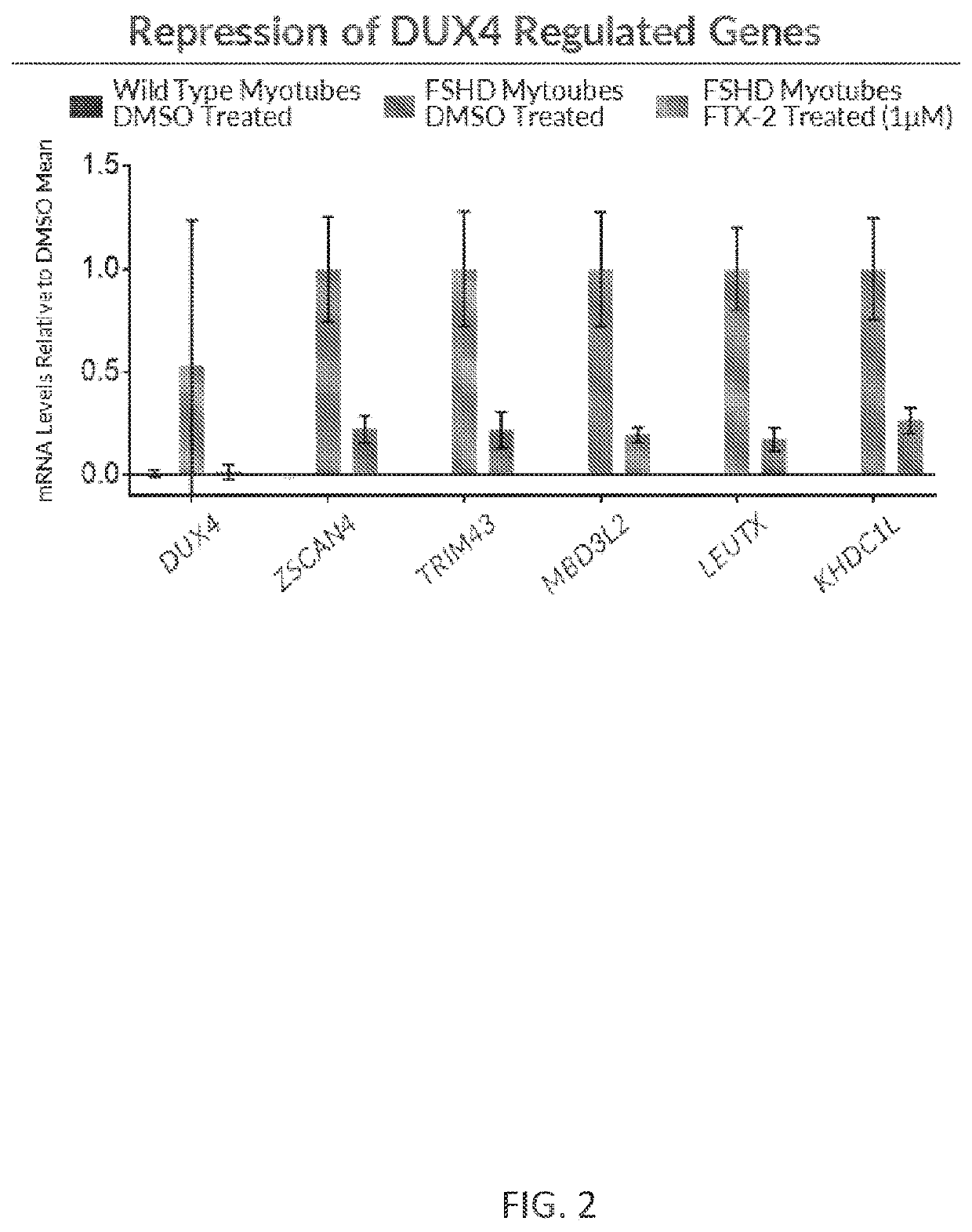Use of p38 inhibitors to reduce expression of dux4
a technology of p38 inhibitors and dux4, which is applied in the direction of peptides, drug compositions, aerosol delivery, etc., can solve the problems of failure to repress dux4, and achieve the effect of reducing the amount of active p38 protein, reducing the apoptosis of cells, and reducing the expression of dux4-fl
- Summary
- Abstract
- Description
- Claims
- Application Information
AI Technical Summary
Benefits of technology
Problems solved by technology
Method used
Image
Examples
example 1
Repression of DUX4 Using Sequence Directed Antisense Oligonucleotide Reduces Downstream Target Genes
[0245]Wild type myotubes were treated with DMSO control vehicle, and mature patient-derived FSHD myotubes that express DUX4 protein were treated with DMSO vehicle control or 1 μM of a DUX4 sequence-directed antisense oligonucleotide (ASO; FTX-2) purchased from Exiqon. After treatment, the myotubes were lysed in 19.5 μL of Roche Real Time Ready Lysis Buffer, 0.25 μL of DNAse1 (Ambion, AM2222), 0.25 μL of Protector RNase Inhibitor (Roche, 3335402001), and the RNA was collected in an RNeasy Micro Kit Master Mix. Expression levels of DUX4-regulated downstream genes (ZSCAN4, TRIM43, MBD3L2, LEUTX, and KHDC1L) was determined by real time PCR (ThermoFisher Scientific, 4484262), ZSCAN4 Taqman Assay (ThermoFisher Scientific, Hs00537549_m1, FAM-MGB), MYOG Taqman Assay (ThermoFisher Scientific, Hs01072232_m1, JUN-QSY), RPLPO Taqman Assay (ThermoFisher Scientific, Hs99999902_m1), and / or LEUTX Taq...
example 2
P38 Small Molecule Inhibitors Reduce MBD3L2 mRNA Expression
[0248]Wild type myotubes and mature patient-derived FSHD myotubes that express DUX4 protein were treated with DMSO vehicle control or multiple concentrations of various p38α / β inhibitors with different ranges of isoform and kinome selectivity, including SB239063 (FIG. 4A), VX-702 (FIG. 4B), Pamapimod (FIG. 4C), and TAK-715 (FIG. 4D). After treatment, the control and treated cells were processed for realtime PCR quantification of MBD3L2 mRNA (DUX4 downstream gene) and myogenin (MYOG) mRNA (control) expression. These p38α / β inhibitors showed potent (IC50 approximately <10 nM, FIGS. 4A-D) reduction of MBD3L2 mRNA expression with no impact to MYOG mRNA expression in FSHD myotubes.
[0249]In FSHD myotubes, p38 inhibitors (e.g., Pamapimod) dose-dependently reduced DUX4 mRNA and DUX4 downstream gene MBD3L2 mRNA expression without impacting myotube formation. When compared to DMSO treatment, 10, 100, and 1000 nM FTX000839 (Pamapimod) ...
example 3
P38 MAPK14 mRNA and MBD3L2 mRNA Reduction via siRNA Knockdown
[0250]p38α MAPK14 85 and p38α MAPK14 86 siRNAs were transfected into patient FSHD myotubes as described in Materials and Methods. Each of p38α MAPK14 85 siRNA and p38α MAPK14 86 siRNA (to a lesser extent) reduced p38 MAPK14 expression, as shown in FIG. 6A, and MBD3L2 mRNA (DUX4 target gene) expression, as shown in FIG. 6B, as compared to non-target control siRNAs (NT CTRL 1 and NT CTRL 2). The data shows that genomic reduction of p38α MAPK14 >50% specifically reduced DUX4 and downstream target genes, as exemplified by MBD3L2.
PUM
| Property | Measurement | Unit |
|---|---|---|
| time | aaaaa | aaaaa |
| time | aaaaa | aaaaa |
| natural abundance | aaaaa | aaaaa |
Abstract
Description
Claims
Application Information
 Login to View More
Login to View More - R&D
- Intellectual Property
- Life Sciences
- Materials
- Tech Scout
- Unparalleled Data Quality
- Higher Quality Content
- 60% Fewer Hallucinations
Browse by: Latest US Patents, China's latest patents, Technical Efficacy Thesaurus, Application Domain, Technology Topic, Popular Technical Reports.
© 2025 PatSnap. All rights reserved.Legal|Privacy policy|Modern Slavery Act Transparency Statement|Sitemap|About US| Contact US: help@patsnap.com



